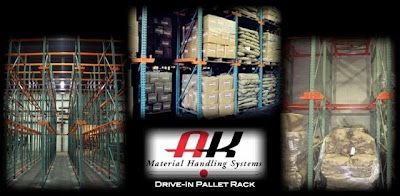
“Drive-In” Pallet rack, as its name implies, is a multiple pallet deep form of storage accomplished by a lift truck driving into an open rack row or lane. Most typically, pallets can be stored from three (3) out to ten (10) “plus” pallets deep. Utilized properly, Drive-In will provide a very high level of storage or product density.
For your reference, this is a “FILO” (First In, Last Out) form of storage. If your application is product rotation sensitive then most likely Drive-In is not the type of rack best suited for you.
Drive-In rack is typically best suited to the following applications:
High-Density Requirements: Freezers, coolers, and all types of expensive storage environments are the most common.
Revenue Warehousing: Whether it’s Public Warehousing, a “3PL,” a Moving & Storage company, or any other type of revenue-based storage business, literally anywhere that charges for storage.
“All In, All Out:” Much like you find in most Produce industry applications is virtually ideal.
Low SKU Counts: Where there are far more pallets than there are SKU’s. “W.I.P” (Work In Process) storage of raw materials is just one example.
Slow Moving Product: Say in the instance of a bulk buy of material that you’ll store for longer periods of time. And product that is not conducive to simply stacking on top of each other.
No Space For Storage: Literally, Drive In provides you an amount of storage capacity that you would not have otherwise. Be it less than ideal for handling reasons, you simply require maximum storage.
Advantages:
1. First, there is the cost. Drive-in systems are $50-$90 per pallet position, push back rack and pallet flow are $100-$250 per pallet position.
2. High-Density Storage.
3. Maximize vertical height- Drive-in can be designed to be a relatively low profiler compared to pushback and pallet flow rack. In other words, because the rails take up less vertical space, you may get another level of storage into your system.
Disadvantages:
1. Load size & uniformity is a critical requirement.
2. Expense. Can easily average 2 times that of standard selective rack.
3. High maintenance. Due to damage from the lift truck driving in and out.
4. Potential for low productivity and/or labor-intensive when not loaded or managed properly.
5. Potential for storage loss due to “honeycombing.”
6. Generally, inflexible and difficult to adjust.
In summary, drive-in pallet rack still has its’ place in this world. Let your material handling professional help you decide if it fits into your warehouse.
If you would like to learn more about drive in pallet rack systems or if you would like to have some information sent to you, please email [email protected] or call one of our Drive-In Pallet Rack System Experts at 800-722-5908.
Helpful Links:
AK Material Handling Drive In Pallet Rack Systems Web Page
Other Pallet Rack Storage Systems
Let’s Talk
Ready to get started? Or have questions about any of our products or services? Fill out the form and a representative will contact you promptly.
About AK Material Handling Systems
We deliver value to our customers by providing the absolute best combination of quality products, helpful customer service and competitive pricing. We specialize in warehouse layout & design, pallet rack systems, engineered sales, mezzanines, modular offices and completed turn-key warehouse systems. For more information email us or call (800) 722-5908

